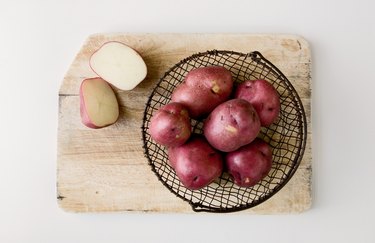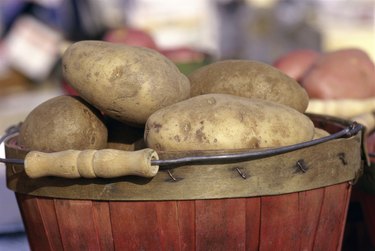In the realm of culinary arts, the humble potato stands as a versatile and indispensable ingredient, gracing countless cuisines worldwide. However, when faced with the choice between red and white potatoes, home cooks and professional chefs alike may ponder the subtle yet significant distinctions that set these two varieties apart. This comprehensive guide delves into the depths of red and white potatoes, exploring their unique characteristics, nutritional profiles, and culinary applications to empower you with the knowledge to make informed choices in your culinary endeavors.
Unveiling the Essence of Red Potatoes
Red potatoes, adorned with their vibrant crimson skin, owe their distinctive hue to a higher concentration of anthocyanin pigments. These pigments, renowned for their antioxidant properties, bestow upon red potatoes the added benefit of being a nutritious choice for health-conscious individuals.
Beyond their visual appeal, red potatoes possess a waxy texture that sets them apart from their white counterparts. This inherent firmness allows red potatoes to maintain their shape even after undergoing the trials of boiling or roasting, making them the ideal choice for dishes such as potato salads, where structural integrity is paramount.
Delving into the Depths of White Potatoes
White potatoes, with their pale skin and starchy interiors, embody the quintessential image of a potato. Their higher starch content translates into a softer, fluffier texture that readily absorbs flavors and sauces. This characteristic makes white potatoes a versatile choice for a wide range of culinary applications, including baking, boiling, frying, and steaming.
A Tale of Two Textures: Waxy vs. Starchy
The fundamental difference between red and white potatoes lies in their contrasting textures. Red potatoes, with their lower starch content, exhibit a waxy texture that allows them to retain their shape during cooking. White potatoes, on the other hand, possess a higher starch content, resulting in a softer, more absorbent texture that readily breaks down during cooking.
Nutritional Nuances: Unraveling the Health Benefits
While both red and white potatoes share a wealth of essential nutrients, including potassium and vitamin C, certain subtle differences exist in their nutritional profiles. Red potatoes, with their vibrant skin, boast higher levels of antioxidants, particularly anthocyanins. These antioxidants have been linked to a reduced risk of chronic diseases, including heart disease and certain types of cancer.
Culinary Applications: Matching Potatoes to Techniques
The distinct textures of red and white potatoes dictate their suitability for various culinary techniques. Red potatoes, with their waxy texture, excel in dishes that require them to maintain their shape, such as potato salads, roasted potatoes, and grilled potatoes. White potatoes, with their starchy texture, are ideal for dishes where a softer texture is desired, such as mashed potatoes, baked potatoes, and potato soups.
Frequently Asked Questions: Unraveling Common Queries
1. Which type of potato is healthier, red or white?
Both red and white potatoes offer a range of essential nutrients, including potassium and vitamin C. However, red potatoes may have a slight edge due to their higher antioxidant content.
2. Can I substitute red potatoes for white potatoes in recipes?
While red and white potatoes share some similarities, their distinct textures may affect the outcome of certain dishes. For instance, substituting red potatoes for white potatoes in mashed potatoes may result in a less creamy texture.
3. What are some popular varieties of red and white potatoes?
Common varieties of red potatoes include Pontiac, Chieftain, Norland, and Red Bliss. Popular white potato varieties include Kennebeck, Cascade, White Rose, and Lady Rosetta.
Red and white potatoes, with their unique textures and flavors, offer a versatile canvas for culinary creativity. Understanding the nuances of each variety empowers you to make informed choices, ensuring that your culinary creations reach their full potential. Whether you seek the waxy firmness of red potatoes or the starchy softness of white potatoes, the world of potatoes awaits your exploration.
White and Red Potato Nutrition
When comparing white and red potato nutrition, theyre almost identical. Red potatoes contain 151 calories per medium potato, while a white potato of the same size clocks in at 159 calories. Both red and white potatoes are high in potassium, containing 943 milligrams and 941 milligrams, respectively. Theyre also both high in vitamin C, with both coming in at 21.8 grams.



But the nutritional fact about red potatoes that probably receives the most attention is their high carb content. A medium red potato has 33. 9 grams of carbohydrates (3. 1 grammes of fiber), whereas a white potato ranks marginally higher at 36 5 grams (3. 6 grams of which come from fiber).
Potatoes are often shunned because theyre high in carbohydrates. Because of a particular type of carbohydrate they contain, they can be a part of a healthy diet for many people, even though diabetics and pre-diabetics may do better avoiding, or at least limiting, them.



High in Resistant Starch
One of the major benefits of red potatoes and white potatoes is that theyre one of a handful of foods that contain resistant starch, which, similar to fiber, is a carbohydrate that your body cant digest. Resistant starch passes through your stomach and small intestine, finally reaching your large intestine where it starts to ferment.
Potatoes are classified as a prebiotic food because the resistant starch in them ferments and feeds the good bacteria in your stomach. This procedure keeps your gut healthy by assisting the good bacteria in growing until they outnumber the bad bacteria.
Potatoes also don’t raise your blood sugar as much as other foods that have similar amounts of carbohydrates but no starch because the resistant starch isn’t digested like other carbohydrates. Potato resistant starch not only aids in blood sugar regulation but also
- Help you feel full
- Prevent constipation
- Decrease bad cholesterol
- Lower the risk of colon cancer
Read more: 7 Kitchen Tricks to Make Carbs Less Fattening
